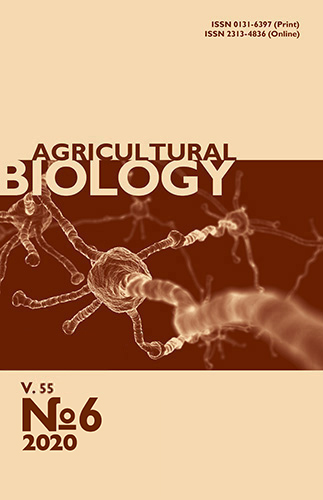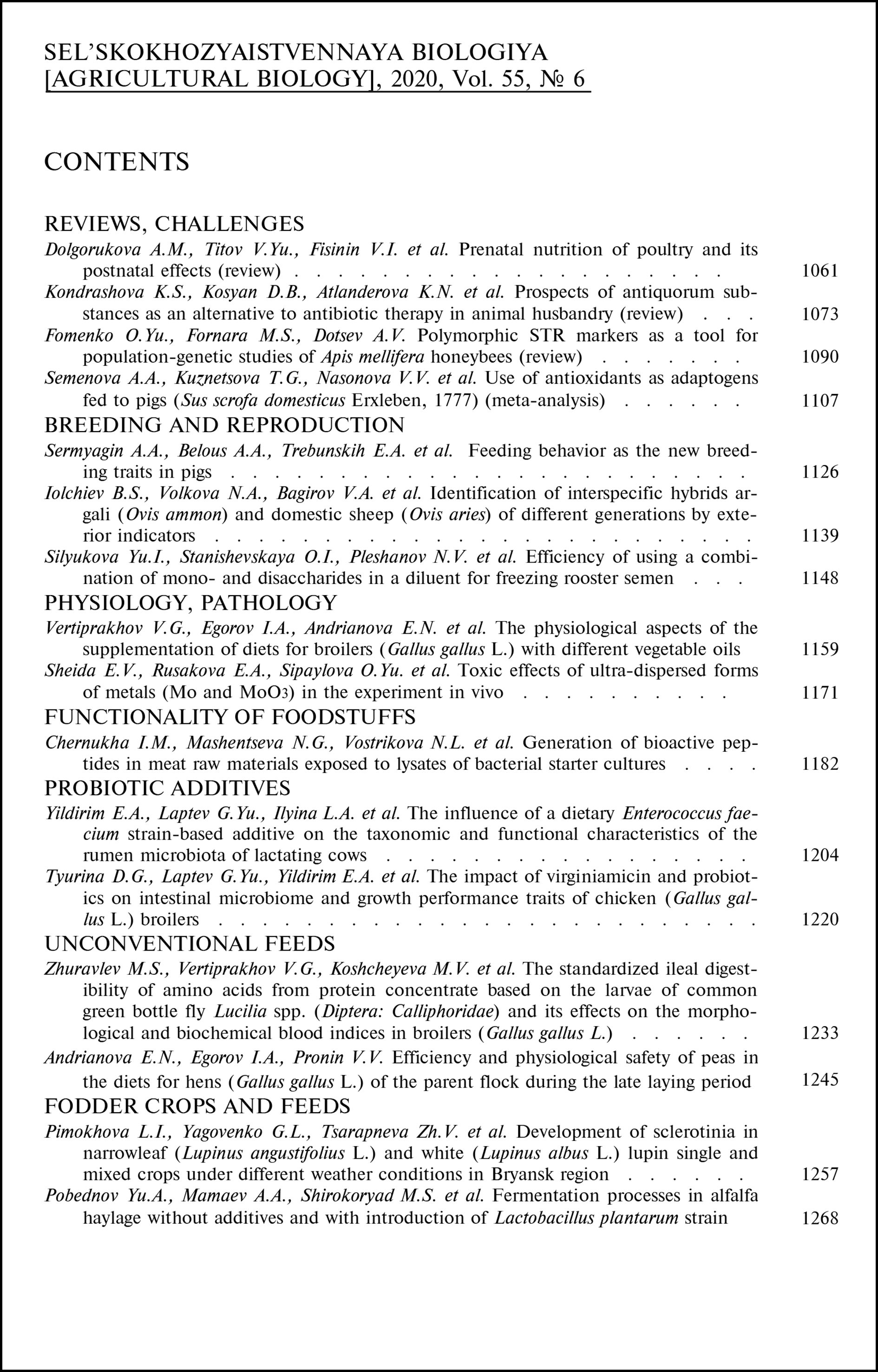doi: 10.15389/agrobiology.2020.6.1139eng
UDC: 636.32/.38:636.082.26:636.061
Acknowledgements:
Supported financially by Russian Science Foundation, grant No. 18-16-00079 and the Ministry of Science and Higher Education of the Russian Federation, theme no. АААА-А18-118021590132-9.
IDENTIFICATION OF INTERSPECIFIC HYBRIDS ARGALI (Ovis ammon) AND DOMESTIC SHEEP (Ovis aries) OF DIFFERENT GENERA-TIONS BY EXTERIOR INDICATORS
B.S. Iolchiev ✉, N.A. Volkova, V.A. Bagirov, N.A. Zinovieva
Ernst Federal Science Center for Animal Husbandry, 60, pos. Dubrovitsy, Podolsk District, Moscow Province, 142132 Russia, e-mail: baylar1@yandex.ru (✉ corresponding author), natavolkova@inbox.ru, vugarbagirov@mail.ru, n_zinovieva@mail.ru
ORCID:
Iolchiev B.S.orcid.org/0000-0001-5386-726
Bagirov V.A. orcid.org/0000-0001-8385-2433
Volkova N.A. orcid.org/0000-0001-7191-3550
Zinovieva N.A. orcid.org/0000-0003-4017-6863
Received August 17, 2020
When creating new breeds and breeding forms, various breeding methods are used, including hybridization. For a long time in the Ernst Federal Science Center for Animal Husbandry, work is underway to use the genetic resources of wild species, in particular argali (Ovis ammon), to obtain interspecific hybrids with domestic sheep (Ovis aries) in the framework of creating new breeding forms and studying the biological characteristics of certain species of the genus Ovis. This raises the question of identifying the obtained interspecific hybrids. Along with conducting expensive studies on the genotyping of such animals, it is of interest to use informative phenotypic indicators characteristic of hybrid individuals. In this work, for the first time, comparative results of differentiation by exterior characteristics of interspecific hybrids of different generations from mating argali with sheep are presented. Romanov breed and original parental forms. The possibility of using exterior indicators for preliminary identification of hybrid individuals without expensive genomic studies was confirmed. Hybridization in the second and subsequent generations resulted in the splitting of hybrid individuals by genotype and phenotype. The work aimed at comparing morphometric parameters of the purebred Romanov sheep and their interspecific hybrids with argali and to reveal informative exterior indicators for identifying hybrid individuals. The lambs of Romanov breed (n = 20) and the interspecific hybrids 1/2 Romanov sheep 1/2 argali (F1, n = 12), 3/8 Romanov sheep 5/8 argali (F3, n = 17), and 7/16 Romanov sheep 9/16 argali (F4, n = 18) were reared from birth under the conditions of vivarium (the Ernst Federal Science Center for Animal Husbandry, 2019-2020). The following measurements were recorded: height in withers, height at the sacrum, back height, oblique body length, body length, chest width, sacrum width, chest depth, metacarpal girth. Linear measurements were taken at the age of 6, 42 days, and 3 months using a measuring tape, tape measure, and a measuring compass. The animals were weighed on an electronic balance. To assess the development of animals on the basis of weight and linear measurements, the body indices were calculated: long-legged index, elongation index, overgrowth index, breast index, bone index, body mass index. The SPSS v.23 software was used for statistical analysis. As a factor influencing the linear measurements of lambs, the breed of individuals was chosen. Hybrid animals at the age of 3 months in comparison with purebred individuals of the Romanov breed had higher indicators of the long-legged index, which is typical for argali. The advantage of F1, F3 and F4 hybrids over purebred animals for this indicator was 4, 8 and 2 %, respectively. At the same time, hybrids F1, F3, and F4 had a more compressed rectangular body shape, therefore, they were inferior to purebred lambs in terms of elongation index, respectively, by 18, 22 and 18 % (p < 0.05). Differences were established between purebred and hybrid animals in linear and latitudinal measurements. The advantage of purebred sheep over F1, F3 and F4 hybrids was 18, 20 and 14 % in oblique body length, 35, 33 and 20 % (p < 0.05) in chest width, and 17, 19 and 7 % (p < 0.05) in chest depth. Hierarchical classification of hybrids and purebred animals according to the exterior characteristics, it showed that interspecific hybrids with 1/2 and 5/8 argali bloodlines were grouped in one cluster. Hybrids with 9/16bloodiness according to the argali and purebred Romanov sheep formed separate clusters. The results obtained confirm that the exterior parameters can be used for preliminary identification of hybrid individuals, in some cases reducing the cost of expensive genomic studies.
Keywords: interspecific hybrids, Ovis ammon, argali, Ovis aries, Romanov breed, exterior.
REFERENCES
- Ulimbashev M.B., Kulintsev V.V., Selionova M.I., Ulimbasheva R.A., Abilov B.T., Alagirova Zh.T. Yug Rossii: ekologiya, razvitie, 2018, 13(2): 165-183 CrossRef
- Marzanov N.S., Apisheva F.K., Marzanova L.K., Samorukov Yu.V., Kertiev R.M. Current description of «breed» concept. Sel'skokhozyaistvennaya biologiya [Agricultural Biology], 2007, 6: 16-23 (in Russ.).
- Stolpovskii Yu.A. Vavilovskii zhurnal genetiki i selektsii, 2013, 17(4-2): 900-915
- Yunusa A.J., Salako A.E., Oladejo O.A. Morphometric characterization of Nigerian indigenous sheep using multifactorial discriminant analysis. International Journal of Biodiversity and Conservation, 2013, 5(10): 661-665 CrossRef
- Salako A.E., Ngere L.O. Application of multifactorial discriminant analysis in the morphometric structural differentiation of the West African Dwarf (WAD) and Yankasa sheep in the South West Nigeria. Nigerian Journal of Animal Production, 2002, 29(1): 163-167.
- Legaz E., Cervantes I., Pérez-Cabal M.A., de la Fuente L.F., Mártinez R., Goyache F., Gutiérrez J.P. Multivariate characterization of morphological traits in Assaf (Assaf.E) sheep. Small Ruminant Research, 2011, 100(2-3): 122-130 CrossRef
- Yadav D.K., Arora R., Jain A. Classification and conservation priority of five Deccani sheep ecotypes of Maharashtra, India. PLoS ONE, 2017, 12(9): e0184691 CrossRef
- Sahana G., Jain A., Maity S.B. Characterization and evaluation of Jalauni sheep. Animal Genetic Resources Information, 2004, 34: 67-73 CrossRef
- Gizaw S., Van Arendonk J.A.M., Komen H., Windig J.J., Hanotte O. Population structure, genetic variation and morphological diversity in indigenous sheep of Ethiopia. Animal Genetics, 2007, 38(6): 621-628 CrossRef
- Yakubu A., Ibrahim I.A. Multivariate analysis of morphostructural characteristics in Nigerian indigenous sheep. Italian Journal of Animal Science, 2011, 10(2): e17 CrossRef
- Deniskova T.E., Selionova M.I., Gladyr' E.A., Dotsev A.V., Bobryshova G.T., Kostyunina O.V., Brem G., Zinov'eva N.A. Variability of microsatellites in sheep breeds raced in Russia. Agricultural Biology [Sel'skokhozyaistvennaya biologiya], 2016, 51(6): 801-810 CrossRef
- Stojiljković M., Stevanović O., Ivanov S., Drobnjak D., Urosević M., Trailović R. Morphometrical characterisation of Karakachan sheep from Stara planina, Serbia. Bulgarian Journal of Agricultural Science, 2015, 21(6): 1278-1284. Bulgarian Journal of Agricultural Science, 21 (No 6) 2015, 1278-1284 AgriculturalAcademy Bulgarian Journal of Agricultural Science, 21 (No 6) 2015, 1278-1284 AgriculturalAcademy
- Otoikhian C.S.O., Otoikhian A.M., Akporhuarho O.P., Isidahomen C. Correlation of body weight and some body measurement parameters in Ouda sheep under extensive management system. African Journal of Agricultural Research, 2008, 3: 129-133.
- Abdel-Moneim A.Y. Use of live body measurements for prediction of body and carcass cuts weights in three Egyptian breeds of sheep. Egyptian Journal of Sheep and Goat Sciences, 2009, 4(2): 17-32.
- Jimmy S., David M., Donald K.R., Dennis M. Variability in body morphometric measurements and their application in predicting live body weight of Mubende and Small East African goat breeds in Uganda. Middle-East Journal of Scientific Research, 2010, 5(2): 98-105.
- Khargharia G., Kadirvel G., Kumar S., Doley S., Bharti P.K., Das M. Principal component analysis of morphological traits of Assam hill goat in eastern Himalayan India. The Journal of Animal and Plant Sciences, 2015, 25(5): 1251-1258.
- Rogić B., Važić B., Jovanović S., Stamenković-Radak M., Savić M., Ravić I. Investigations of variability of morphometric characteristics in Busa and Gatacko cattle in order to preserve autochthonous genome. Veterinarski glasnik, 2011, 65(1-2): 61-69 CrossRef
- Sowande O.S., Sobola O.S. Body measurements of west African dwarf sheep as parameters for estimation of live weight. Tropical Animal Health and Production, 2008, 40(6): 433-439. CrossRef
- Marković B., Dovč P., Marković M., Radonjić D., Adakalić M., Simčič M. Differentiation of some Pramenka sheep breeds based on morphometric characteristics. Arch. Anim. Breed., 2019, 62: 393-402 CrossRef
- DekhiliM. A morphometric study of sheep reared in north-east Algerian. Arch. Zootec., 2014, 63(244): 623-631 CrossRef
- Dmitrieva T.O. Evraziiskii Soyuz Uchenykh, 2019, 19(66): 9-11 CrossRef (in Russ.).
- Babale D.M., Hussein A.U., Gworgwor Z. Relationship between liveweights, linear body measurements and cost prices of small ruminants sold in and around mubi environs, adamawa state, Nigeria. J. Dairy Vet. Anim. Res., 2018, 7(6): 273-277 CrossRef
- Chniter M., Hammadi M., Khorchani T., Krit R., Lahsoumi B., Sassi M.B., Nowak R., Hamouda M.B. Phenotypic and seasonal factors influence birth weight, growth rate and lamb mortality in D’man sheep maintained under intensive management in Tunisian oases. Small Ruminant Research, 2011, 99(2-3): 166-170 CrossRef
- Koyuncu M., Uzun S.K. Growth performance of Karacabey Merino and Kivircik lambs under semiintensive management in Turkey. Small Ruminant Research, 2009, 83(1-3): 64-66 CrossRef
- Estrada-Angulo A., Castro-Pérez B.I., Urías-Estrada J.D., Ríos-Rincón F.G., Arteaga-Wences Y.J., Barreras A., López-Soto M.A., Plascencia A., Zinn R.A. Influence of protein level on growth performance, dietary energetics and carcass characteristics of Pelibuey × Katahdin lambs finished with isocaloric diets. Small Ruminant Research, 2018, 160:59-64 CrossRef
- Georges M. Recent progress in livestock genomics and potential impact on breeding programs. Theriogenology, 2001, 55(1): 15-21 CrossRef
- Rosov A., Gootwine E. Birth weight and pre- and postweaning growth rates of lambs belonging to the Afec-Assaf strain and its crosses with the American Suffolk. Small Ruminant Research, 2013, 113(1): 58-61 CrossRef
- Park I.S., Woo S., Song Y.C., Cho S. Effects of starvation on morphometric characteristics of olive flounder, Paralichthys olivaceus. Ichthyol. Res., 2007, 54(3): 297 CrossRef
- Popoola M.A., Oseni S.O. Multifactorial discriminant analysis of cephalic morphology of Indigenous breeds of sheep in Nigeria. Slovak J. Anim. Sci., 2018, 51(2): 45-51.
- Gizaw S., Van Arendonk J.A.M., Komen H., Windig J.J., Hanotte O. Population structure, genetic variation and morphological diversity in indigenous sheep of Ethiopia. Animal Genetics, 2007, 38(6): 621-628 CrossRef
- Koseniuk A., Ropka-Molik K., Rubiś D., Smołucha G. Genetic background of coat colour in sheep. Arch. Anim. Breed., 2018, 61(2): 173-178 CrossRef
- Eastham C., Nicholls M. Morphometric analysis of large Falco species and their hybrids with implications for conservation. Journal of Raptor Research, 2005, 39(4): 386-393.












